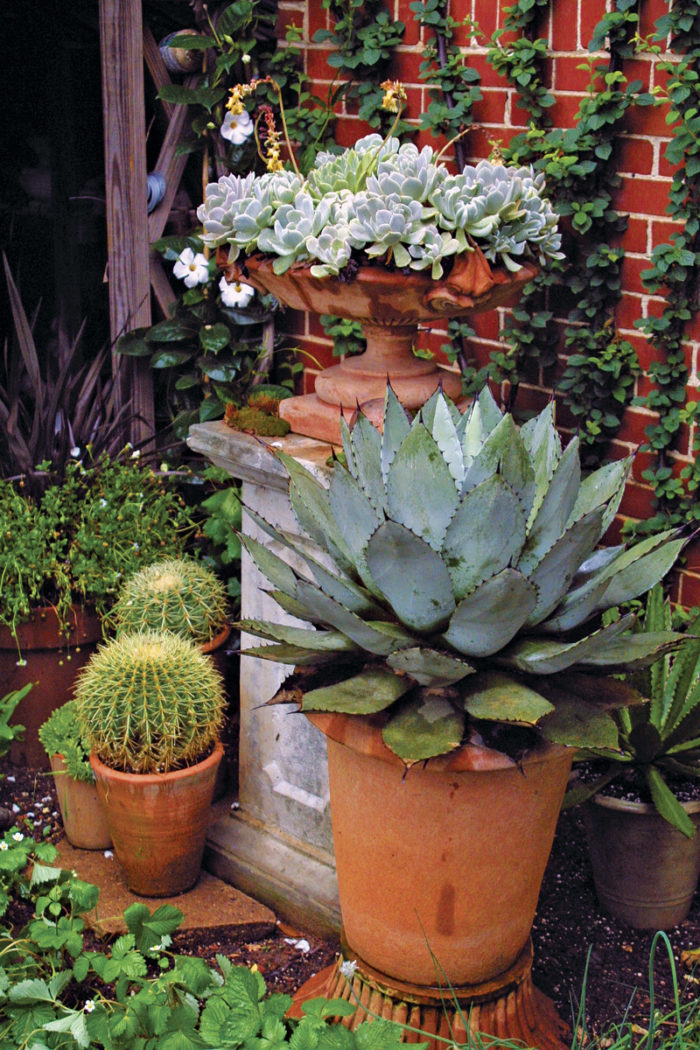
Succulents are the modern designer’s favorite freaks and geeks. They are a celebration of geometric form so rigid that the plants hardly seem to be living things. They can look like stones, can be toothed as an alligator, and can occasionally morph into monstrosities that defy genetics. Every gardener should have at least one succulent plant. Despite plant tags and grower tips, however, some of these fleshy fellows remain notoriously fickle—prone to sudden meltdown, rot, and mummification. With so many succulents out there, it’s impossible for home gardeners to tell the easy growers from the finicky specialties. The selections here offer a diverse mix of no-brainers to help you get started without risk of failure.
 1. Add color to a dreary winter
1. Add color to a dreary winter

Name: Paddle plant (Kalanchoe thyrsiflora)
USDA Hardiness Zones: 10 to 11
Size: 1 foot tall and wide
Conditions: Bright shade
Paddle plant is the most popular modern succulent due to its whimsical form and intense winter color. Its leaves are flat, like pancakes, layered into an odd rosette. This plant bolts when it blooms, with the center stem elongating into a gangly white stalk. Those sold in nurseries are youngsters raised to maximum size for immediate use, but they do not last more than a year before bolting, which spoils their looks. Once paddle plant flowers, cut off the stem and give the remnant of the plant good care. It will soon produce many new offsets that can be plucked off and rooted.
2. The succulent for zinnia lovers
Name: Tree aeonium (Aeonium arboreum
and cvs.)
Zones: 9 to 11
Size: 6 to 24 inches tall and wide
Conditions: Full sun to light shade
If a zinnia were a succulent, it would be a tree aeonium. This species features two of the hottest varieties in the modern succulent world. Deep burgundy to black ‘Zwartkop’ (pictured) is a powerful contrast against light green or yellow plants. ‘Sunburst’ has large cream-colored variegated leaves that can take on pink highlights. Over time, tree aeonium develops a thick trunk and may branch into sizable subshrubs that produce foot-long, cone-shaped stems of vivid yellow flowers.

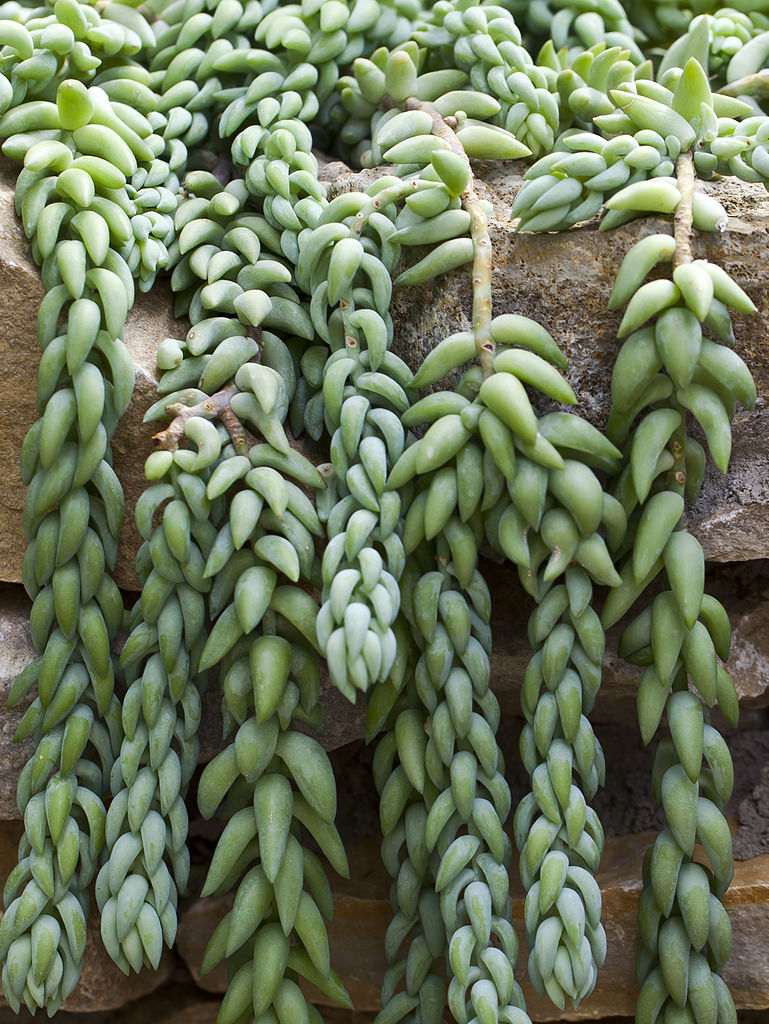 |
3. Donkey’s tail is a unique spillerName: Donkey’s tail (Sedum morganianum) Zone: 11 Size: 2 feet long and 1 foot wide Conditions: Bright shade Show children a donkey’s tail and they will reach out to pinch the leaves of this unique vinelike succulent. It’s typically grown in a hanging basket where perfect drainage is assured. It also grows well dangling from a pot on a wall or balcony. This is not a heat lover, but it’s a cinch to grow in spots protected from wind. Give it a shaded location with filtered light for best results. |
 4. Get the flames—without the fire
4. Get the flames—without the fire

Name: Firesticks (Euphorbia tirucalli ‘Rosea’)
Zones: 9 to 11
Size: 3 feet tall and 2 feet wide
Conditions: Full sun
The pencil tree has been around forever, but Firesticks, the red form of the species, is a great design tool for its fine texture and vivid winter hues. The color is the result of reduced chlorophyll, which stunts growth and keeps this succulent small. The most intense color occurs in winter on plants in full sun. This species is more tolerant of ordinary soil than most succulents, so it’s often planted alongside moisture-loving plants.
5. A single specimen is all you need
Name: Queen Victoria agave (Agave victoriae-reginae)
Zones: 9 to 11
Size: 1 foot tall and wide
Conditions: Full morning sun
A mature specimen of the small Queen Victoria agave can cost as much as a thousand dollars. But like all members of the Agave genus, it blooms just once at the end of its life (so you’ll most likely never see a bloom). Slow growth and exquisite beauty make this a prime single specimen. A mature plant is roughly the size of a volleyball and is rock hard, while the leaves are edged in white lines, which lend unique graphic quality to the plant.
 6. Small doesn’t equal wimpy
6. Small doesn’t equal wimpy

Name: Zebra haworthia (Haworthia attenuata)
Zone: 11
Size: 2 to 4 inches tall and 3 to 4 inches wide
Conditions: Full sun to filtered shade
Rub your finger along the leaves of this crocodile of a succulent to feel the unique hard warts that pock the surface. Though small, zebra haworthia’s hard, leathery surface makes it downright hard to kill—except with excess water or frost. This plant is a favorite for shallow bowls or bonsai pots, where it offsets freely, soon filling up the pot. It blooms on long piano-wire stalks with small, simple white flowers.
7. Pick a color, any color

Name: Echeveria (Echeveria spp. and cvs.)
Zones: 9 to 11
Size: 1 to 2 inches tall and 3 to 4 inches wide
Conditions: Full sun to light shade
Echeveria is a collection of truly awesome succulents. The availability of dozens of different-colored hybrids makes them the paint-box plants to pair with glass gravel for outstanding potted specimens, though they look equally amazing in the landscape. Selecting by hand, rather than mail ordering, is the best method of getting the color you have in mind.
 8. If you love blue, you’re in luck
8. If you love blue, you’re in luck

Name: Blue chalk sticks (Senecio mandraliscae)
Zones: 10 to 11
Size: 1 to 2 feet tall and wide
Conditions: Full sun
No succulent rivals this one for true blue coloring. It’s favored for mixed-succulent bowls, where it pops against yellow succulents. Blue chalk sticks can be shrubby or low spreading depending on the form you buy and whether you shape it. Leaves are pencil thin and upright, creating a spiky, fine-textured mass. This is an exceptional choice for unusual form in windowsill gardens.
9. Hummingbirds love this spider

Name: Spider aloe (Aloe humilis)
Zones: 9 to 11
Size: 4 to 5 inches tall and wide
Conditions: Light shade
Fat and stubby, this cute little aloe blooms just as spectacularly as its larger African relatives. In spring, a foot-long spike emerges, topped with tubular, coral red blooms that hummingbirds find irresistible. This hand-size plant is ideal for low, wide bonsai pots. Its toothy leaves are thick and stiff, so its precise form is maintained at all times without flopping. Pairing several spider aloes with smooth river stones makes a beautiful little grouping.
10. This succulent bears the cold
Name: Cobweb houseleek (Sempervivum arachnoideum)
Zones: 5 to 8
Size: 3 inches tall and 6 to 8 inches wide
Conditions: Full sun to partial shade
This cold-hardy succulent is one of the cutest small rosettes. It stands up to winter cold because it originates in the high mountains of Europe, where plants thrive in decomposing granite pockets on sun-drenched cliffs. Cobweb houseleek is named for the spiderlike appearance created when stems arch outward from between the leaves to bear offsets. These offsets are easy to sever and root into new plants. If you want to try this one, provide it with good drainage.
Fine Gardening Recommended Products

The Crevice Garden: How to make the perfect home for plants from rocky places
Fine Gardening receives a commission for items purchased through links on this site, including Amazon Associates and other affiliate advertising programs.

SHOWA Atlas 370B Nitrile Palm Coating Gloves, Black, Medium (Pack of 12 Pairs)
Fine Gardening receives a commission for items purchased through links on this site, including Amazon Associates and other affiliate advertising programs.

Gardener's Log Book from NYBG
Fine Gardening receives a commission for items purchased through links on this site, including Amazon Associates and other affiliate advertising programs.

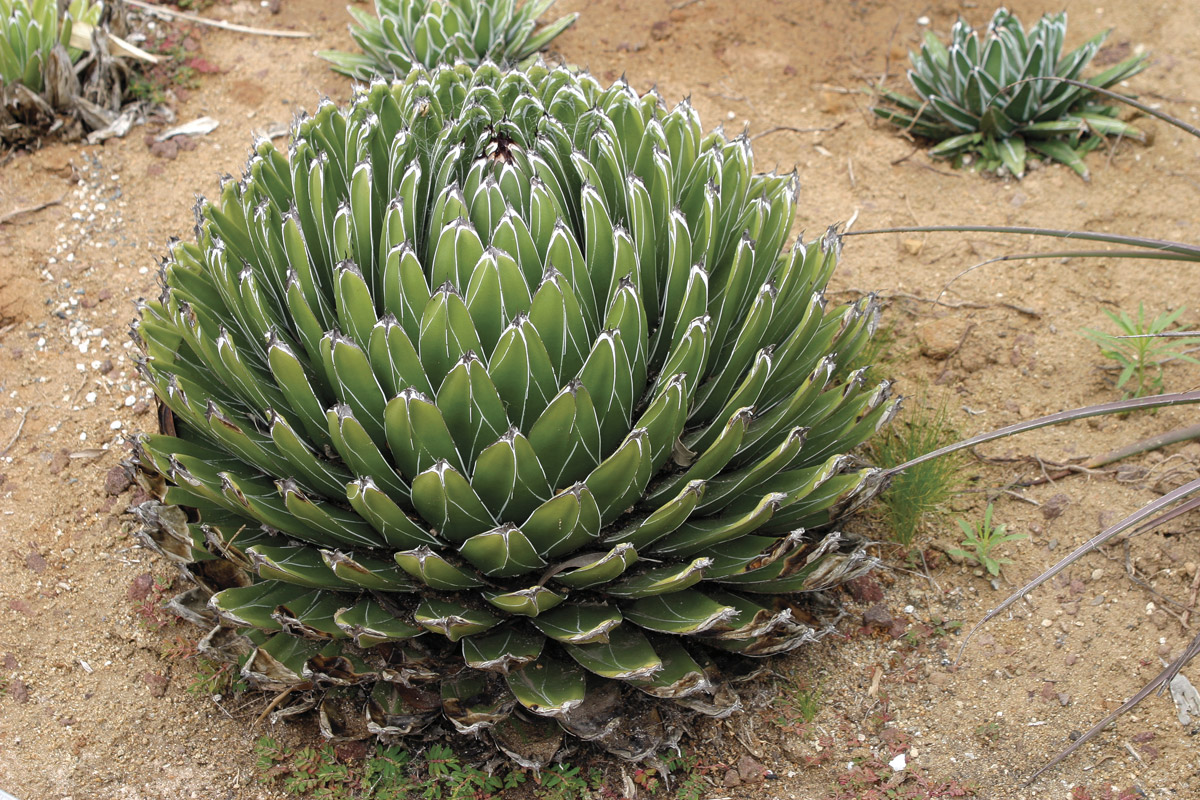
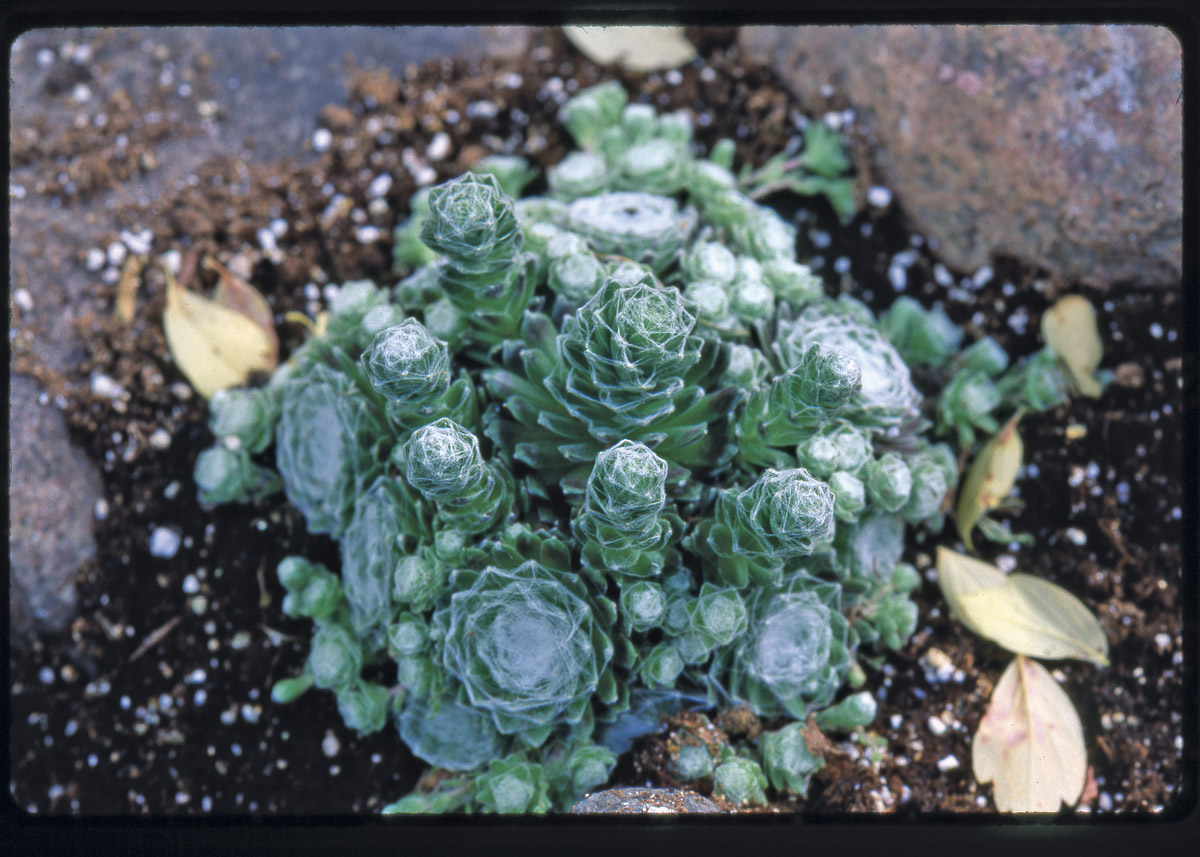
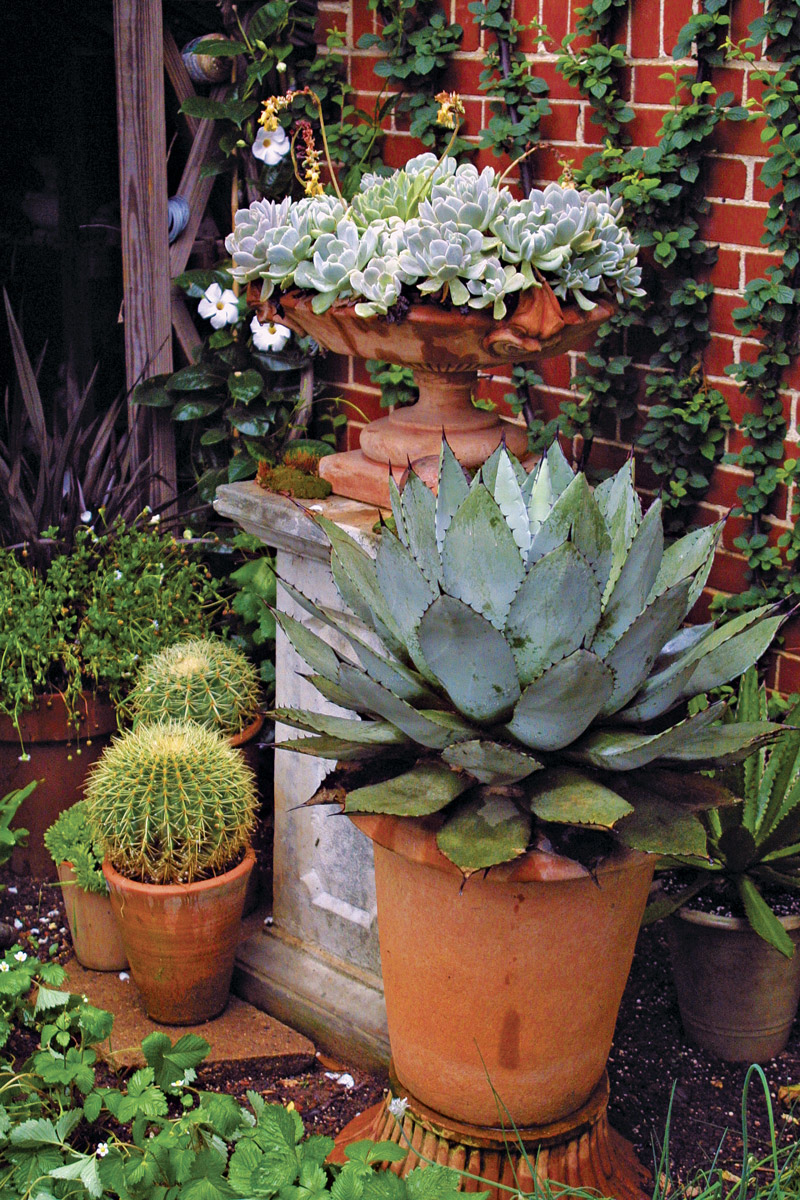
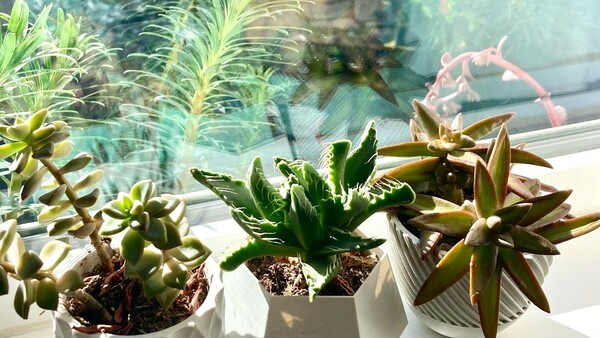
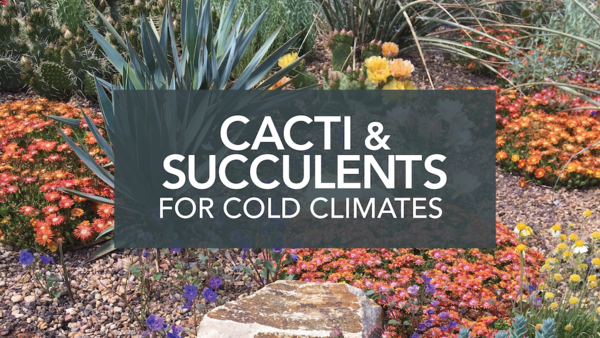

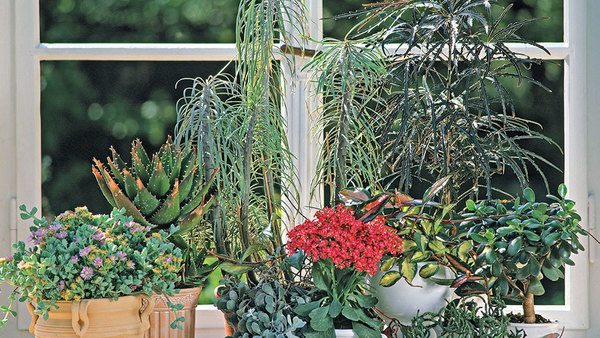













Comments
Loved the article on succulents, but noticed that all of them only survive in Zones 9 & higher! Are these zones USDA or Sunset, which are specifically designed for the American SW?? How about an article about succulents that are Hardier, say zones 6-9 (Sunset)????
What about the houseleek mentioned above? That says it survives in snow!
I grow a lot of these succulents, mostly those in the Echeveria family & other rosette forming varieties. I bring them in after summer; they survive with very little care in an east facing window. I enjoy them in winter when I have no garden outside!
I really appreciate reading this blog it is full of knowledge and informative content good work keep it up
https://www.buyreplicawatches.io/
I've planted tons of succulents outdoors and so far only 1 died due to too much rain in winter, all the others are blooming fairly well.
I like succulents and I'm glad to see more people using them. Too bad most plantings look just like the sales area at a Home Depot - a mix of a bunch of different succulents.
At the nursery I keep seeing a succulent or maybe kalanchoe which looks very similar to the paddle plant. It's called a flapjack plant. I never get it because of the zone indicated. Maybe l I will get one and experiment with keeping it over the winter. I love the Queen Victoria Agave (not just because of the name!) and wonder what a small starter plant might cost given the expense of the mature plant.
Useful information about the right soil mix, care and feeding to keep them going.
marvelous
fascinating
Be careful while taking care of aeonium. You do not need to cut off the aeonium in size or shape, because they remain naturally neat and small. Regular pruning and maintenance will help keep your aeronists at their best. Cut any dead leaves or spindle, improperly formed stems at the base using sharp scissors or scissors. Before trimming aeronyms, rinse your trimming tools in a fully durable household disinfectant for five minutes and rinse them thoroughly. Dead leaves and other garden debris sometimes make their way between curved tightly packed aeonia leaves.
https://domyhomeworkonline.net/do-my-accounting-homework.php
Log in or create an account to post a comment.
Sign up Log in